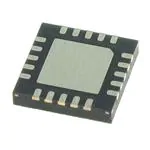Maxim > Design Support > Technical Documents > Application Notes > Basestations/Wireless Infrastructure > APP 3632
Maxim > Design Support > Technical Documents > Application Notes > Communications Circuits > APP 3632
Maxim > Design Support > Technical Documents > Application Notes > High-Speed Interconnect > APP 3632
Keywords: mixers, local oscillators, LO, wide-band, transmitter, receiver, transceiver, cellular base
station, noise, SAW, linearity, high-dynamic range, mixer noise, NF, signal-to-noise ratio, SNR,
modulation, diplexer
APPLICATION NOTE 3632
Wideband LO Noise in Passive Transmit-Receive
Mixer ICs
Sep 23, 2005
Abstract: Passive double-balanced mixers comprised of FET quads and diode-rings can work as up- or
down-converters in cellular base-station transceivers. High-linearity (IP3), low-noise, and spuriousresponse up- and down-converters requiring low-level local-oscillator signals have been realized by
integrating buffer amplifiers along with the FET or diode mixer cores. Wideband noise in the buffer
amplifier stages impairs the received and transmitted signals. This noise can be characterized and
specified by a single parameter. By introducing a noise parameter in dBc/Hz for the passive mixer IC,
the user can calculate the system-related impairments when using the IC in base-station transmit and
receive applications.
Introduction
Cellular base-station transmitters should, ideally, transmit all their power within their own frequency
allocation. This poses a challenge, even without spectral re-growth due to power amplifiers. The
wideband residual phase-noise floor present in the upconverted transmit signal produces co-siting
difficulties with receivers. This broadband noise is at a significantly lower level than the close-in phase
noise, but it can be of sufficiently high level to deafen a co-located receiver. In conventional discrete
passive diode or FET mixer cores used in base-station transmitters, the LO ports are matched to 50Ω
and it is possible to filter the wideband noise before applying the LO signal into the LO port. In integrated
mixer and modulator solutions that provide internal local-oscillator driver stages, the wideband input
noise is degraded by the internal circuitry. The upconverted signal takes on the spectral skirt and floor of
the local-oscillator buffer output. Specifying and designing for lower wideband noise in LO buffers
produces lower out-of-band transmit noise. This will ease the rejection requirements of high-Q transmit
filters and diplexer filters in front-end equipment.
Cellular base-station receivers have to deal with high-level blocking interferers when receiving weak inband signals. The blocking signals reciprocally mix with noise in the local oscillator at the mixer core and
increase the noise floor inside the signal band at the IF output. This note reviews base-station mixer ICs
and noise in mixers, and specifies one single parameter to address both the single-tone desensitization
of the receiver when used as a downconverter and out-of-band wideband transmit noise when used as
an upconverter.
Base-Station Mixers
Page 1 of 8
�Passive-diode and FET-ring mixers have always been the workhorses of base-station receivers. These
devices require large external local-oscillator drives—greater than 17 dBm—to achieve a high IP3.
Figure 1 shows how a passive discrete mixer is used in a base-station receiver. They work with discrete
IF amplifiers driving surface acoustic wave (SAW) filters and require drive from discrete LO buffer
amplifiers. Though active-IC Gilbert mixers with gain are available, they do not meet the demanding
linearity and noise requirements of base stations [2,3]. However, there have recently been a number of
new silicon mixer ICs [7] with very high linearity (IP3 = 34dBm) and low noise (NF = 7dB) to meet basestation requirements. These mixers have internal local-oscillator drivers, eliminating the need for largesignal, external driver amplifiers. The passive mixer-based ICs are reciprocal devices unlike the Gilbertcell counterparts. They can work as up- and downconverters. With cascaded IF amplifiers they yield high
IP3 (26dBm), and low NF (
很抱歉,暂时无法提供与“MAX9994ETP-T”相匹配的价格&库存,您可以联系我们找货
免费人工找货